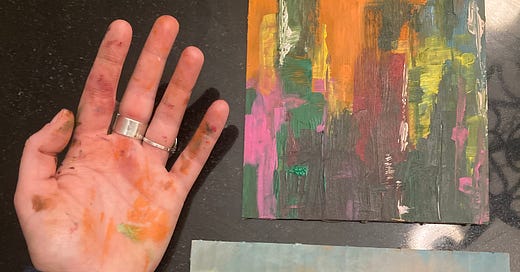Whatever May Be, May Be: The Dawn of a New Doris Day
Turning Your Que Sera, Sera [What Will Be] to Lo Que Puede Ser [What Can Be]
The month of May has been more about music than art-making for me personally. Granted there was one evening of much need art therapy, when a piece of cardboard and a couple tubes of paint provided a peaceful Sunday respite across from a friend that reminded me how much I love to get paint on my hands. As we sat painting en plain air on his back porch under strings of lights, the faint sounds of country music played at a distance. When I asked him where the music was coming from he said his neighbor plays the music for the chickens and that I shouldn’t be surprised if I hear Tracy Chapman’s “Fast Car” at least three times before I leave. Laughable as it sounded to me then, I suppose even animals can resonate with the sounds of music.
A few more times throughout the month I had concert-going experiences, including one of my favorite artist of all time and another allowed for being outdoors, playing to a crowd of canopies and lawn chairs. As the weather turns nicer, and more summer-like by the day, hearing songs played in open-air is just as magical as plain air painting can be.
This month also, for whatever reason, had me thinking about all my “may be’s,” you know, the possibilities, the things that could be, the uncertainties, or as Doris Day once sang, “Que Sera, Sera,” a spanglish-esque phrase meaning, “What will be, will be.” That specific song was a key plot element in Alfred Hitchcock’s 1956 film, “The Man Who Knew Too Much,” starring Day and Jimmy Stewart. After a fateful vacation in Morocco, the couple becomes caught in the middle of an assassination attempt, while their son is kidnapped by the assassin’s accomplices. Only at the end, when Day’s character sings “Que Sera, Sera” does she hear her son whistling along to her singing and Stewart’s character then recuses the boy from his captures. The song, based on its lyrics, is an ode to the uncertainties of life, admitting a truism that “The future’s not ours to see.”
At the start of May, I carried this perspective like the song, “Que Sera, Sera” of “whatever happens, happens.” In part, I think it is a defense mechanism for being disappointed so much in the previous month, when life didn’t work out how I wanted or expected it to, so I felt safer to let life happen to me, rather than have a say in how it could go. However, as the month of May marched on, weeks passing with time, I came to a different conclusion that actually disagrees with or challenges the “what will be, will be” mindset. Instead, it’s the “lo que puede ser,” which translates from Spanish to English as “what can be.”
Shifting my thoughts from the “may’s” to the “can’s” has given me an agency in the outcomes that I typically feel powerless over. Maybe I’ll visit there one day. Maybe I’ll start my own business someday. Maybe I’ll say yes to that thing I always wanted to do. Maybe I’ll reach out to that person. Maybe is so unsure. Maybe is so uncertain. Maybe is so uncommitted. So rather over the course of this month I’ve said, I can visit there next month. I can start my own business as soon as I put my mind to it. I can say yes to things I want. I can reach out to friends I haven’t talked to in years. I can. I can. I can.
Is it just me, or can you hear the difference, too? It makes everything seem more possible, purposeful, direction-oriented. Not lackadaisical, not far off, and certainly not so uncertain.
In May, I turned my may be’s into can do’s. It does feel like a dawn of a new [Doris] day, in which I wake up less crippled by doubt and unknowns, and more sure of the things I want out of life. Of course, every day isn’t a the perfect balance of may verses can, but it’s getting better and those may be’s in life feel much closer to can be’s.
As this month comes to a close, where do you need to turn your “may’s” into “can’s”?
-GM
Gina McKlveen is the writer and visionary behind imaginartist. She graduated from Saint Vincent College in 2017 with dual Bachelor of Arts degrees in Studio Art and English with a concentration in Literature and Politics. In 2021, she graduated from The George Washington University Law School where she focused her studies in Intellectual Property Law and did not abandon her love for the arts. Gina currently resides in Pennsylvania where she is both a practicing attorney and artist.




